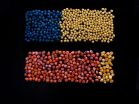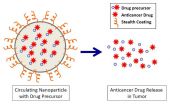Depression and insomnia are strongest risk factors for frequent nightmares
Nightmare frequency appears to have a strong connection with sleep and mood problems
2015-04-02
(Press-News.org) DARIEN, IL - A new study suggests that symptoms of depression and insomnia are the strongest predictors of having frequent nightmares.
Results show that 3.9 percent of participants reported having frequent nightmares during the previous 30 days, including 4.8 percent of women and 2.9 percent of men. Frequent nightmares were reported by 28.4 percent of participants with severe depressive symptoms and 17.1 percent of those with frequent insomnia. Further analysis that adjusted for potential confounders found that the strongest independent risk factors for nightmares were insomnia, exhaustion and the depressive symptom of "negative attitude toward self."
"Our study shows a clear connection between well-being and nightmares," said lead author Nils Sandman, a researcher in the Centre for Cognitive Neuroscience at the University of Turku in Finland. "This is most evident in the connection between nightmares and depression, but also apparent in many other analyses involving nightmares and questions measuring life satisfaction and health."
Study results are published in the April issue of the journal Sleep.
The American Academy of Sleep Medicine reports that nightmares are vivid, realistic and disturbing dreams typically involving threats to survival or security, which often evoke emotions of anxiety, fear or terror. A nightmare disorder may occur when repeated nightmares cause distress or impairment in social or occupational functioning.
The study was a joint effort of the University of Turku and the Finnish National Institute of Health and Welfare. Sandman and the research team analyzed data from two independent cross-sectional surveys of the Finnish general adult population conducted in 2007 and 2012. Participants were 13,922 adults between 25 and 74 years of age. Fifty-three percent were women. The surveys involved a questionnaire that was mailed to the participants and a health examination at the local primary health care center, where the completed questionnaire was returned and checked by a nurse. Occasional nightmares in the past 30 days were reported by more than 45 percent of participants, and 50.6 percent reported no nightmares at all.
Sandman noted that the cross-sectional study did not allow for an examination of causality. However, he suggested that the results do raise intriguing possibilities worth investigating in the future.
"It might be possible that nightmares could function as early indicators of onset of depression and therefore have previously untapped diagnostic value," he said. "Also, because nightmares, insomnia and depression often appear together, would it be possible to treat all of these problems with an intervention directed solely toward nightmares?"
INFORMATION:
Financial support for the study was provided by the Jenny and Antti Wihuri Foundation, Finnish
National Doctoral Programme of Psychology, Sigrid Juselius Foundation, University of Helsinki, Turku Institute for Advanced Studies, and Academy of Finland.
To request a copy of the study, "Nightmares: Risk Factors Among the Finnish General Adult Population," or to arrange an interview with the study author or an AASM spokesperson, please contact Communications Coordinator Lynn Celmer at 630-737-9700, ext. 9364, or lcelmer@aasmnet.org.
The monthly, peer-reviewed, scientific journal Sleep is published online by the Associated Professional Sleep Societies, LLC, a joint venture of the American Academy of Sleep Medicine and the Sleep Research Society. The AASM is a professional membership society that improves sleep health and promotes high quality patient centered care through advocacy, education, strategic research, and practice standards. A searchable directory of AASM accredited sleep centers is available at http://www.sleepeducation.org.
ELSE PRESS RELEASES FROM THIS DATE:
2015-04-02
Bethesda, MD (April 2, 2015) -- Non-alcoholic steatohepatitis (NASH), the more severe form of non-alcoholic fatty liver disease (NAFLD) that can progress to liver fibrosis and cirrhosis, is associated with leakiness of the intestinal wall, which in turn may worsen liver disease, according to research1 published in Cellular and Molecular Gastroenterology and Hepatology, the new basic science journal of the American Gastroenterological Association.
"Our study strengthens the clinical association between intestinal permeability and NASH, although we were unable to identify ...
2015-04-02
Accurate blood pressure measurement (BP) is fundamental to the early diagnosis of hypertensive disorders in pregnancy, says a review published 1 April, 2015, in The Obstetrician & Gynaecologist (TOG).
The diagnosis and management of hypertensive disorders in pregnancy, as well as obstetric haemorrhage, sepsis and safe abortion, are guided in part by the measurement of BP. These conditions contribute to more than half of all maternal deaths globally, so the accuracy of BP measurement is vital, the review concludes.
The review explains that BP monitoring is the most ...
2015-04-02
BATON ROUGE - LSU Psychology Professor Megan H. Papesh was part of a research team whose study appeared in the online-first edition of the Journal of Neuroscience on Wednesday, April 1.
The research, jointly conducted by scientists from the Barrow Neurological Institute and Arizona State University, involves recording single-neuron activity in the brains of epilepsy patients who require electrodes implanted to monitor seizures. With the electrodes in place, processes such as perception and memory can be studied at the level of individual neurons.
The research focused ...
2015-04-02
As man-made threats to coral reefs mount and interest in conserving reef ecosystems grows, scientists have turned to studying extremely remote and uninhabited reefs in an effort to understand what coral reefs would be like in the absence of humans. A number of islands and atolls in the Pacific Ocean remain virtually untouched by human influence, situated hundreds of kilometers from the nearest human populations.
A study published today by scientists at the University of Hawai'i at Mānoa (UHM) School of Ocean and Earth Science and Technology (SOEST), the National ...
2015-04-02
MADISON, Wis. - Clearing grasslands to make way for biofuels may seem counterproductive, but University of Wisconsin-Madison researchers show in a study today (April 2, 2015) that crops, including the corn and soy commonly used for biofuels, expanded onto 7 million acres of new land in the U.S. over a recent four-year period, replacing millions of acres of grasslands.
The study -- from UW-Madison graduate student Tyler Lark, geography Professor Holly Gibbs, and postdoctoral researcher Meghan Salmon -- is published in the journal Environmental Research Letters and addresses ...
2015-04-02
Use of a class of insecticides, called neonicotinoids, increased dramatically in the mid-2000s and was driven almost entirely by the use of corn and soybean seeds treated with the pesticides, according to researchers at Penn State.
"Previous studies suggested that the percentage of corn acres treated with insecticides decreased during the 2000s, but once we took seed treatments into account we found the opposite pattern," said Margaret Douglas, graduate student in entomology. "Our results show that application of neonicotinoids to seed of corn and soybeans has driven ...
2015-04-02
Delving into the world of the extremely small, researchers are exploring how biodegradable nanoparticles can precisely deliver anticancer drugs to attack neuroblastoma, an often-deadly children's cancer.
By bringing together experts in pediatric oncology with experts in nanotechnology, researchers at The Children's Hospital of Philadelphia aim to thread the needle of delivering effective doses of cancer-killing agents while avoiding toxicity in healthy tissues. The team's new research shows that this approach inhibits tumor growth and markedly prolongs survival in animal ...
2015-04-02
DENVER - Exercise and physical activity should be considered as therapeutic options for lung cancer as they have been shown to reduce symptoms, increase exercise tolerance, improve quality of life, and potentially reduce length of hospital stay and complications following surgery for lung cancer.
Lung cancer is the leading cause of cancer deaths in the United States with an estimated 160,000 deaths each year and worldwide there are 1.4 million deaths. In the last two decades lung cancer therapy has improved, but the overall 5-year survival rate is still quite low at 17%. ...
2015-04-02
A particular molecular pathway permits stem cells in pediatric bone cancers to grow rapidly and aggressively, according to researchers at NYU Langone Medical Center and its Laura and Isaac Perlmutter Cancer Center.
In normal cell growth, the Hippo pathway, which controls organ size in animals, works as a dam, regulating cell proliferation. What the researchers found is that the transcription factor of a DNA binding protein called sex determining region Y box 2, or Sox2 for short, which normally maintains cell self-renewal, actually releases the floodgates in the Hippo ...
2015-04-02
ARLINGTON HEIGHTS, Ill. (April 2, 2015) - No home is perfect, but dysfunction in the home is now revealed to be especially dangerous for children at risk for asthma. A new study shows that children exposed to just one adverse childhood experience (ACE) had a 28 percent increased chance of developing asthma than those with no ACEs.
The study, published in the Annals of Allergy, Asthma and Immunology, the scientific publication of the American College of Allergy, Asthma and Immunology (ACAAI), used data from the National Survey of Children's Health. The survey drew from ...
LAST 30 PRESS RELEASES:
[Press-News.org] Depression and insomnia are strongest risk factors for frequent nightmares
Nightmare frequency appears to have a strong connection with sleep and mood problems


